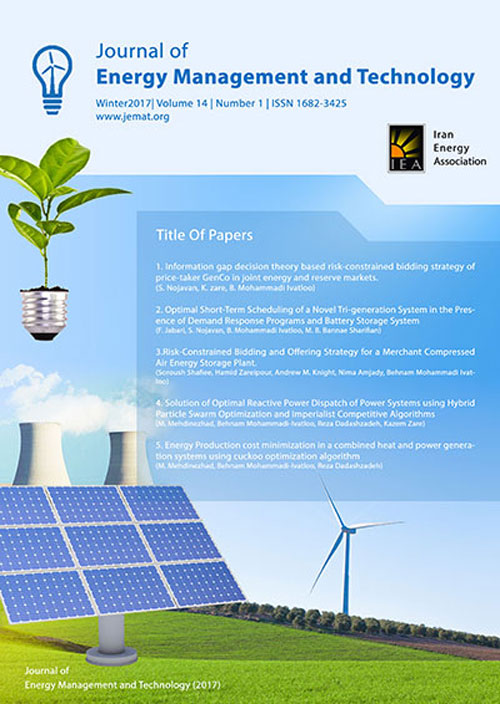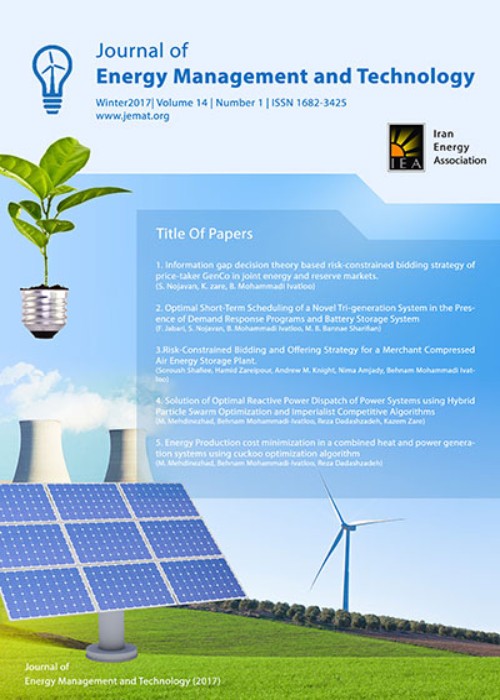فهرست مطالب

Journal of Energy Management and Technology
Volume:5 Issue: 3, Summer 2021
- تاریخ انتشار: 1399/10/29
- تعداد عناوین: 5
-
-
Pages 1-7TThis paper presents a direct predictive speed control strategy to control a permanent magnet synchronous motor (PMSM) fed by a three-level neutral-point clamped converter (NPC). A new cost function is proposed by incorporating the speed dynamic, the current dynamic and the system constraints to have a good performance without additional outer-loop PI speed controller. The current dynamic added to cost function is based on the concept of the sliding mode control (SMC). Moreover, a load torque observer is used for better performance of the proposed method and the stability of the observer is presented. By combining new reference value of the current into the cost function, the necessity to multiple horizon in the predictive speed control (PSC) is obviated, the effects of the current dynamic on the transient conditions is considered so current distortion and torque fluctuation is reduced considerably and the controller acts as fast as an original direct speed control without cascade structure. Simulation results using MATLAB/SIMULINK demonstrate the performance of the proposed scheme.Keywords: Model predictive Control, Sliding mode control, Three-Level NPC, Permanent Magnet Synchronous Motor
-
Pages 8-20
This study addresses Civilized Gravitational Search Algorithm (CGSA) as a new mass intelligence optimization algorithm for solving optimal single and multiple DG placement problems in the electrical distribution networks. The proposed technique utilizes the modified search procedure of Society Civilization Algorithm (SCA) combining with Newtonian laws of GSA. It mainly consists of two steps. The first step provides a candidate list for DG allocation based on active power loss minimization and the second one searches simultaneously the optimal DG size(s) and location(s) using Self-Adoptive Learning (SAL) strategy. In order to verify the capabilities and effectiveness of the suggested approach, all simulations are conducted through IEEE 33- and 69-bus electrical distribution networks. Moreover, 23 standard functions are examined to verify the stability of the proposed algorithm on different low- and high-dimensional functions. Comparisons demonstrate the superior performance of the presented method to provide better solution quality with a fast convergence characteristic.
Keywords: Optimal DG placement, Distribution network, civilized gravitational search algorithm, active power loss minimization -
Pages 21-29In an inconsistent view of energy systems, the interaction between different energy carriers is not taken into account. In such a view, the considered problem is not well optimized. The idea of an integrated looking into several carriers has been proposed by creating the energy hub concept. Due to the simultaneous attention of all energy carriers, long-term planning and short-term operation have converted to complicated challenges. To this end, this study focuses on the energy hub operation for cost minimization. In addition to considering reliability indices for different loads, diversity constraint is regarded as a key point to increase energy security. Sensitivity analysis of the degree of diversity and its effects on operation costs and Expected Energy not Supply (EENS), play a vital role in the final decision. LINDOGlobal solver is employed in GAMS to implement Mixed Integer Nonlinear Programming (MINLP) model. A sample energy hub, considering three carriers in the input port and three loads in the output port, is used as a test system, and results are discussed in depth.Keywords: Energy hub, Economic Dispatch, Diversity Constraint, Reliability
-
Pages 30-42The limitation of energy resources is becoming a serious crisis in the world. Considering the energy and environmental crises caused by the excessive consumption of energy in the world, it is necessary to revise design methods and use sustainable and valuable models in the design of buildings in order to provide thermal comfort. Architecture in the shadow of the earth is a valuable and sustainable model which has high energy conservation capability acts along the protection of the environment via energy conservation and adapts with the needs of the era. The present research is aimed to explain the concepts of earth-sheltered architecture and determine the effect of design and use of underground spaces in environmental sustainable design, architectural harmony with the climate, and energy conservation. In this research, using descriptive-analytical research method based on library and documentary studies as well as field survey, the earth-sheltered architectural concepts are explored and successful samples of the world and valuable models in Iranian traditional architecture are introduced. In the case study, the physical features of a few samples of underground spaces in Tabriz as well as heat waste or absorption from walls are examined at different depths. The results of the study indicate that heat waste or absorption rate via walls depends on the underground physical properties, contact of walls with the outside air, and burial level of buildings. Benefiting from the potential of underground spaces and use of ground depth in architectural design has led to developing relatively stable conditions against adverse conditions of climate and environmental balance. Utilizing the values of experiences could provide a solution for solving a part of the current energy crisis and creation of responsive environments in terms of climate and application.Keywords: Earth-Sheltered Architecture, sustainable, energy conservation, climatic comfort, energy consumption
-
Pages 43-53Iran, not just as an oil-exporting country, but also because of its geopolitical position, is one of the world’s most important countries. Since the recent events of the Middle East, the importance of the country has grown globally. Because of this growing importance, the short term future of Iran is significant to be studied. In this study, a descriptive approach has been taken to synthesize the world’s energy portfolio and the global energy balance outlook to provide insights into the development of local energy portfolio scenarios focusing on Iran. The shell company represents two basic scenarios, which are the scramble and blueprint. According to shell scenarios world energy portfolio might be organized in two images in which each image concludes different energy portfolios. Thus, developing energy portfolio scenarios is essential. In this paper, after reviewing the four selected developing countries’ energy portfolios and developed countries, the scenarios of Iran’s energy portfolio in 2020-2025 will be presented. For this purpose, a combination of qualitative and quantitative methods will be used for scenario building.Keywords: Energy Policy, Scenario Planning, Public Policy, Strategic Planning


